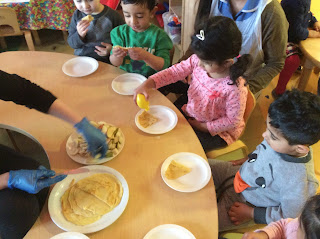Lisa and Halima attended a Phonics workshop on Monday 30th January and thought it would be useful to feedback the information to our families:
What is phonics?
Phonics is a fundamental part of learning to read the English language. It is the relationship between sounds (phonemes) and spellings (graphemes). Phonics aims to build children's speaking and listening skills in their own right as well as to prepare children for learning to read by developing their awareness of sounds.
There are 6 Phases that should be taught to children from Pre School to Year 2.
What is Phase 1?
Phase 1 recognises the importance of developing speaking and listening skills as a priority in their own right and for paving the way to making a good start on reading and writing.
Phase 1 activities are arranged under the following seven aspects:
■ Aspect 1: Environmental sounds
■ Aspect 2: Instrumental sounds
■ Aspect 3: Body percussion
■ Aspect 4: Rhythm and rhyme
■ Aspect 5: Alliteration
■ Aspect 6: Voice sounds
■ Aspect 7: Oral blending and segmenting
What do we do in Nursery?
Environmental sounds - The aim of this aspect is to raise children's awareness of the sounds around them and to develop their listening skills.
■ Exploring books that include noises ie Peace at Last
■ Listening walk to the forest
■ Group time activities
■ Guess the object noise (with eyes closed) ie bells
Instrumental sounds - This aspect aims to develop children's awareness of sounds made by various instruments and noise makers.
■ Making own shakers to explore how sounds can be changed
■ Listening to instructions 'loud/ quiet, 'stop/go'
■ Use of instruments during story ie the door slammed (bang the drum)
Body percussion - The aim of this aspect is to develop children's awareness of sounds and rhythms.
■ What noises we can make with our body clap, click,stamp, pat etc
■ Following a pattern clap, stamp,clap,stamp
■ Using outdoor area as much as possible encourages children to explore different ways of making sound with their body
■ Dough disco - patting, rolling etc to the music
Rhythm and Rhyme - This aspect aims to develop children's appreciation and experiences of rhythm and rhyme in speech.
■ Nursery rhymes
■ Inventing new rhymes ie Hickory dickory dable the mouse ran up the ???
■ Rhyming bags fox, box, socks, zip - which word is the odd one out?
■ Tapping, clapping, stamping out their name
Alliteration - The focus is on initial sounds of words. Alliteration is identified by the repeated sound of the first letter in a series of multiple words.
■ Group time - using their name ie
Lisa
Likes
Lollies
■ Tongue twisters ie during sand play 'she sells sea shells'
■ What's in the bag....
Mouse,
Monkey,
Mole,
Snake which is the odd one out?
Voice Sounds - The aim is to distinguish between different vocal sounds and to begin oral blending and segmenting.
■ Voice changers (microphones)
■ Make trumpets out of paper - how your voice changes
■ Stories ie Bear Hunt swish swish, squelch squelch
Oral blending and segmenting - In this aspect, the main aim is to develop oral blending and segmenting skills.
For more information on this google: Letters and Sounds / Jolly Phonics or speak to Lisa/ Halima.
Note: Primary Schools teaching of phonics varies so don't focus too much on this, concentrate more on Aspects 1-6.
If you would like a copy of activity ideas for each of the Aspects please email l.parkinson@stmarysblackburn.ac.uk to request a copy.














































